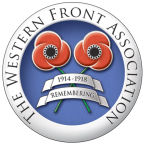10th Battalion, Worcestershire Regiment

Henry John Peart (probably known as Harry) was one of two sons born to Joseph Peart (who died in 1900) and his wife Sarah Jane (née Howell) who died in 1911.
Harry was born at Over, Gloucester in 1882 and his brother, Albert in 1885.
In January 1905 Harry married Emily Jones and the couple had four children, all living at the time of the 1911 Census, when the family lived at 14 Park Street, Gloucester. Harry’s occupation at the time was that of a railway wagon repairer, possibly with the Gloucester Railway Carriage & Wagon Company, a major employer in the city at that time.
Very little documentary evidence of Harry’s Army career has survived.
He is named as a recruit for ‘Lord Kitchener’s New Army’ in the 5 September edition of the Gloucester Journal, still living at 14 Park Street.
We know from one of the two surviving Medal Index Entitlement Cards (MIEC) that he enlisted on 4 September 1914 and joined the Worcestershire Regiment, and was posted to the 10th Battalion.
The battalion was raised in Worcester in September 1914, as part of Kitchener’s Second Army and was assigned to 57 Brigade, 19 (Western) Division.
Training took place on Salisbury Plain at Perham Down and Tidworth before the battalion was sent to the Western Front in late July 1915. After landing at Boulogne, 19th Division was concentrated around St Pol and took part in a diversionary action at Pietre, in support of the main British Expeditionary Force (BEF) offensive at Loos in September 1915.
Following this the 10th Worcesters saw action during the 1916 Somme Offensive between July and November, notably the capture of La Boiselle and attacks on High Wood, Pozieres Ridge, Ancre Heights and the Ancre.
In the absence of service record (probably one of the many destroyed by enemy action in WW2) it is not possible to determine in how many of the above actions Harry was a participant.
At some point he transferred to the 46th Battalion Training Reserve and was given the number TR9/28432): this was previously the 13 (Reserve ) Battalion, Worcestershire Regiment and logic suggested that Harry had returned from the Western Front, either sick or wounded and upon recovery was posted to a unit which prepared men for service abroad.
However, confusingly, one of his MIEC does link him with the Northamptonshire Regiment. We know from one of these that he was discharged as sick on 27 February 1917, a fact confirmed by the award of a Silver War Badge (to signify discharge from previous military service), the record of which states that discharge was due to varicose veins in both legs.
A recently released Pension Record Card states that he was also suffering from pulmonary tuberculosis which was contracted on active service.
Whether this condition was linked to his premature death, at the age of 38, on 31 March 1921 is not known, as no Army pension records have been found. However, his presence in the Commonwealth War Graves Commission ‘Debt of Honour’ register would imply a death related to military service (before the cut off date of 31 August 1921).
He was buried in Gloucester Old Cemetery, where a standard CWGC headstone marks his grave.
Research by Graham Adams 11 September 2019 (revised 5 August 2021)
